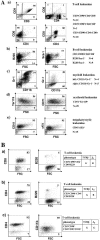Novel insights into the pathogenesis of the Graffi murine leukemia retrovirus
- PMID: 16571819
- PMCID: PMC1440465
- DOI: 10.1128/JVI.80.8.4026-4037.2006
Novel insights into the pathogenesis of the Graffi murine leukemia retrovirus
Abstract
The Graffi murine leukemia virus (MuLV) was isolated in 1954 by Arnold Graffi, who characterized it as a myeloid leukemia-inducing retrovirus. He and his team, however, soon observed the intriguing phenomenon of hematological diversification, which corresponded to a decrease of myeloid leukemias and an increase of other types of leukemias. Recently, we derived two different molecular clones corresponding to ecotropic nondefective genomes that were named GV-1.2 and GV-1.4. The induced leukemias were classified as myeloid based on morphological analysis of blood smears. In this study, we further characterized the two variants of the Graffi murine retrovirus, GV-1.2 and GV-1.4, in three different strains of mice. We show that the Graffi MuLV is a multipotent retrovirus capable of inducing both lymphoid (T- and B-cell) and nonlymphoid (myeloid, erythroid, megakaryocytic) leukemia. Many of these are very complex with concomitant expression of different hematopoietic lineages. Interestingly, a high percentage of megakaryocytic leukemias, a type of leukemia rarely observed with MuLVs, arise in the FVB/n strain of mice. The genetic backgrounds of the different strains of mice influence greatly the results. Furthermore, the enhancer region, different for GV-1.2 and GV-1.4, plays a pivotal role in the disease specificity: GV-1.2 induces more lymphoid leukemias, and GV-1.4 induces more nonlymphoid ones.
Figures





Similar articles
-
Graffi murine leukemia virus: molecular cloning and characterization of the myeloid leukemia-inducing agent.J Virol. 1993 Aug;67(8):4722-31. doi: 10.1128/JVI.67.8.4722-4731.1993. J Virol. 1993. PMID: 8392610 Free PMC article.
-
Phenotyping of Evi1, Evi11/Cb2, and Evi12 transformed leukemias isolated from a novel panel of cas-Br-M murine leukemia virus-infected mice.Virology. 2000 Mar 15;268(2):308-18. doi: 10.1006/viro.2000.0183. Virology. 2000. PMID: 10704339
-
Biological characterization and molecular cloning of murine C-type retroviruses derived from the TSZ complex from mainland China.Virology. 1995 Oct 1;212(2):367-82. doi: 10.1006/viro.1995.1494. Virology. 1995. PMID: 7571406
-
Genetic heterogeneity in acute myeloid leukemia: maximizing information flow from MuLV mutagenesis studies.Leukemia. 2000 Jul;14(7):1174-84. doi: 10.1038/sj.leu.2401852. Leukemia. 2000. PMID: 10914539 Review.
-
The pathophysiology of murine retrovirus-induced leukemias.Crit Rev Oncol Hematol. 1986;5(3):257-323. doi: 10.1016/s1040-8428(86)80041-5. Crit Rev Oncol Hematol. 1986. PMID: 3527464 Review.
Cited by
-
Retroviral insertions in the VISION database identify molecular pathways in mouse lymphoid leukemia and lymphoma.Mamm Genome. 2007 Oct;18(10):709-22. doi: 10.1007/s00335-007-9060-2. Epub 2007 Oct 10. Mamm Genome. 2007. PMID: 17926094 Free PMC article.
-
Mutant nucleophosmin and cooperating pathways drive leukemia initiation and progression in mice.Nat Genet. 2011 May;43(5):470-5. doi: 10.1038/ng.796. Epub 2011 Mar 27. Nat Genet. 2011. PMID: 21441929 Free PMC article.
-
Acute myeloid leukaemia: a paradigm for the clonal evolution of cancer?Dis Model Mech. 2014 Aug;7(8):941-51. doi: 10.1242/dmm.015974. Dis Model Mech. 2014. PMID: 25056697 Free PMC article. Review.
-
Analysis of regulatory sequences in exosomal DNA of NANOGP8.PLoS One. 2023 Jan 25;18(1):e0280959. doi: 10.1371/journal.pone.0280959. eCollection 2023. PLoS One. 2023. PMID: 36696426 Free PMC article.
-
Characterization and identification of PARM-1 as a new potential oncogene.Mol Cancer. 2013 Jul 31;12:84. doi: 10.1186/1476-4598-12-84. Mol Cancer. 2013. PMID: 23902727 Free PMC article.
References
-
- Abrahao, T. B., E. Freymuller, R. A. Mortara, J. D. Lopes, and M. Mariano. 2003. Morphological characterization of mouse B-1 cells. Immunobiology 208:401-411. - PubMed
-
- Barat, C., and E. Rassart. 1998. Nuclear factors that bind to the U3 region of two murine myeloid leukemia-inducing retroviruses, Cas-Br-E and Graffi. Virology 252:82-95. - PubMed
-
- Borrello, M. A., and R. P. Phipps. 1995. Fibroblasts support outgrowth of splenocytes simultaneously expressing B lymphocyte and macrophage characteristics. J. Immunol. 155:4155-4161. - PubMed
Publication types
MeSH terms
LinkOut - more resources
Full Text Sources
Molecular Biology Databases

